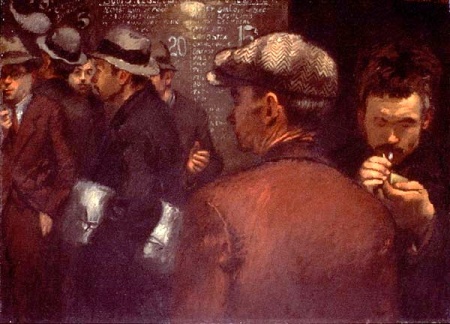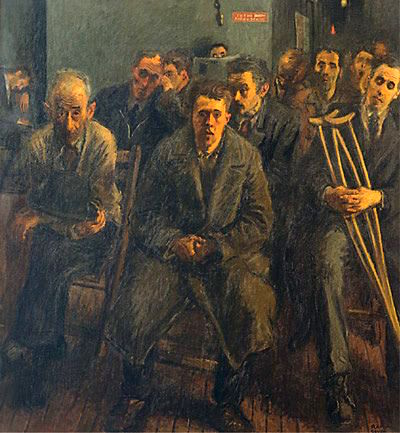New York artist Raphael Soyer’s style of painting was seriously out of fashion during his lifetime.

[“Nocturne,” from 1935, inspired by Soyer’s “Bowery Nocturne” lithograph done two years earlier]
Born in Russia in 1899, his family arrived in the Bronx in 1912.
Soyer soon went to work, holding menial jobs. But throughout the teens, he also studied art, taking free classes at Cooper Union and the Art Students League.

[“Employment Agency,” from the 1930s]
Rather than the abstract style that was popular in the 1930s and beyond, his work was realistic—he cast his eye on the lonely and downtrodden working-class New Yorkers he saw in bars, employment agencies, and on city streets.

[“Office Girls,” from 1936]
With his twin brother Moses and another sibling, Isaac, he was a leading Social Realist.
Soyer sketched and painted compassionate images of lonely and dispossessed Bowery bums, shopgirls, and secretaries going about their lives and appearing ordinary, unheroic, yet deeply human.

[“Sixth Avenue,” 1930-1935]
His 1987 New York Times obituary contains an exchange Soyer once had with Jackson Pollack, which Soyer recounted in an article in Art & Antiques magazine:

[“Cafe Scene,” 1940]
“Without greeting me he rudely said, ‘Soyer, why do you paint like you do?’ ” Mr. Soyer wrote. ”He pointed to an airplane. ‘There are planes flying, and you still paint realistically. You don’t belong to our time.’ ”
”I could have said to Jackson, ‘If I don’t like the art of our time, must I belong to our time?’ But I did not say that. I merely said that I paint the way I like to.”







